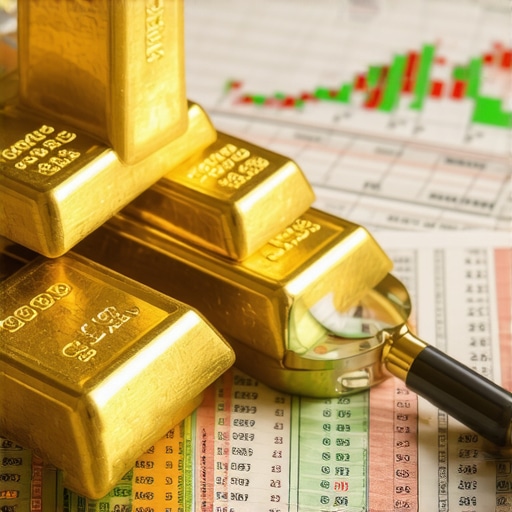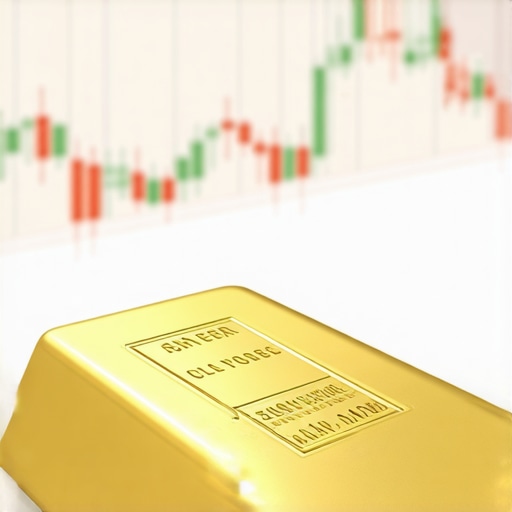Unlocking the Potential of Gold: An Expert’s Perspective on 2025 Investment Opportunities
As we approach 2025, discerning investors are increasingly turning to precious metals, particularly gold, to diversify portfolios and hedge against economic volatility. The evolving landscape of global finance necessitates a nuanced understanding of which gold coins and bars offer the most strategic value. In this article, we delve into the sophisticated considerations that define optimal gold investments for long-term wealth growth, informed by market analysis, economic indicators, and expert insights.
Why Gold Remains a Cornerstone of Wealth Preservation in 2025
Gold’s enduring reputation as a safe-haven asset is rooted in its intrinsic value and historical resilience. According to a comprehensive gold market analysis, the demand for physical gold is projected to increase, driven by geopolitical tensions and inflationary pressures. These factors underscore the strategic importance of selecting high-quality coins and bars that maximize liquidity and security in volatile markets.
Expert-Recommended Gold Coins & Bars for 2025
Investors should prioritize widely recognized, government-minted gold coins such as the American Gold Eagle, Canadian Gold Maple Leaf, and South African Krugerrand. These coins combine purity, liquidity, and international acceptance, making them ideal for long-term wealth preservation. For bullion bars, reputable mints like Perth Mint and Credit Suisse produce bars with high purity and standardized weights, facilitating seamless trade and storage.
Advanced Considerations: Numismatic Value vs. Bullion
While bullion coins and bars are primarily valued for their gold content, certain numismatic coins possess additional value due to rarity and collector appeal. Analyzing market trends and grading reports can unlock hidden appreciation potential, especially in limited editions or historically significant coins. However, for consistent growth and liquidity, most investors favor the pure bullion products.
What are the most effective strategies for integrating gold coins and bars into a diversified portfolio in 2025?
Effective diversification involves balancing physical gold holdings with ETFs and mining stocks. The top gold ETFs and mutual funds serve as complementary instruments, offering liquidity and exposure to broader market trends. An expert approach also involves assessing economic indicators such as inflation rates, currency stability, and central bank policies, which significantly influence gold prices.
Furthermore, developing a trust-based gold IRA can provide tax advantages and secure retirement wealth. Long-term strategies should emphasize gradual accumulation, secure storage, and regular portfolio reviews aligned with macroeconomic shifts.
For a comprehensive understanding of how global economic factors will influence gold prices in 2025, consult authoritative reports such as the long-term investment strategies and economic outlook analyses.
Investors are encouraged to leverage expert insights, diversify across physical and financial gold assets, and stay informed about market developments to optimize wealth growth in 2025 and beyond.
Harnessing Innovative Approaches: How Can Investors Optimize Gold Holdings in 2025?
As the global economy continues to evolve, savvy investors are exploring advanced methods to enhance their gold portfolios. Incorporating derivatives such as gold futures and options can serve as powerful tools for hedging risks and capitalizing on short-term market movements. According to a detailed expert guide on gold futures trading, mastering technical analysis and timing entry and exit points are crucial for maximizing gains while minimizing losses.
Are Gold ETFs Truly a Diversification Game-Changer in 2025?
Gold ETFs and mutual funds offer liquidity and ease of access, making them attractive for diversifying holdings without the complications of physical storage. However, investors should carefully evaluate the underlying assets and management strategies of these funds. A trusted analysis of gold ETFs for 2025 underscores the importance of selecting funds with transparent holdings, low expense ratios, and a proven track record of performance, especially during volatile periods.
What are the nuanced risks and rewards of combining physical gold with financial instruments in a balanced portfolio?
This question taps into the core of sophisticated wealth management. Physical gold provides tangible security, while financial instruments like ETFs and mining stocks offer liquidity and exposure to broader market dynamics. A balanced approach involves assessing the macroeconomic landscape, including inflation trends, currency stability, and central bank policies, which influence gold’s performance. According to a comprehensive retirement-focused gold investment strategy, integrating these assets strategically can optimize long-term growth and risk mitigation.
Furthermore, investors should stay informed about emerging demand trends, such as jewelry consumption and technological uses, which can subtly impact gold prices. For an in-depth understanding of these factors, refer to the authoritative gold demand analysis for 2025.
Engaging with expert insights and continuously monitoring global economic indicators will be essential for refining your gold investment approach in 2025. Share your thoughts or questions in the comments below, and explore our detailed articles to deepen your strategic knowledge for a resilient financial future.
Leveraging Market Cycles: How Economic Indicators Shape Gold’s Long-Term Trajectory in 2025
Understanding the intricate relationship between macroeconomic indicators and gold prices is essential for sophisticated investors aiming to optimize their 2025 portfolio. Key factors such as inflation rates, currency devaluation, and geopolitical stability directly influence gold’s demand. For instance, a rising inflation environment, as detailed in the IMF’s World Economic Outlook, tends to elevate gold prices due to its status as an inflation hedge. Conversely, periods of economic stabilization often see decreased gold demand, emphasizing the importance of timing and strategic allocation.
How do central bank policies influence gold’s strategic role in diversified portfolios?
Central bank policies, especially regarding interest rates and quantitative easing, are pivotal in shaping gold’s investment landscape. When central banks adopt accommodative monetary policies, real interest rates tend to decline, reducing the opportunity cost of holding non-yielding assets like gold. According to the Bank for International Settlements, these policies can lead to increased gold holdings by investors seeking safe havens amid currency debasement concerns. For wealth managers, aligning gold allocations with anticipated policy shifts can significantly enhance risk-adjusted returns.
Integrating Advanced Derivatives for Dynamic Risk Management
Beyond physical holdings and ETFs, sophisticated investors are increasingly utilizing derivatives such as gold options and futures to hedge against short-term volatility. Mastering these instruments requires a nuanced understanding of technical analysis and market sentiment. For example, employing options strategies like straddles or protective puts can safeguard gains during turbulent periods, as elucidated in the CME Group’s educational resources. This approach allows investors to fine-tune their exposure, balancing risk and liquidity, especially in anticipation of macroeconomic shocks or policy announcements.
What is the role of geopolitical risk assessments in shaping gold investment strategies?
Geopolitical tensions, such as trade conflicts or regional conflicts, often catalyze surges in gold demand. Advanced investors employ geopolitical risk assessment models, integrating real-time intelligence, to anticipate market reactions. Tools like the Stratfor geopolitical intelligence platform provide granular insights that inform strategic entry and exit points. Recognizing early signs of escalating tensions can enable investors to position their holdings advantageously, leveraging gold’s safe-haven status amidst uncertainty.
For those seeking to deepen their understanding, consulting comprehensive economic and geopolitical analyses from sources like the Economist Intelligence Unit can be invaluable. These insights help craft resilient strategies that adapt to evolving global dynamics, ensuring your gold investments remain aligned with long-term wealth preservation goals.
Interested in mastering these advanced investment techniques? Stay engaged with our expert content, subscribe for updates, and join discussions with fellow seasoned investors committed to navigating the complexities of gold markets in 2025 and beyond.
Harnessing Market Cycles: How Economic Indicators Shape Gold’s Long-Term Trajectory in 2025
Understanding the intricate relationship between macroeconomic indicators and gold prices is essential for sophisticated investors aiming to optimize their 2025 portfolio. Key factors such as inflation rates, currency devaluation, and geopolitical stability directly influence gold’s demand. For instance, a rising inflation environment, as detailed in the IMF’s World Economic Outlook, tends to elevate gold prices due to its status as an inflation hedge. Conversely, periods of economic stabilization often see decreased gold demand, emphasizing the importance of timing and strategic allocation.
How do central bank policies influence gold’s strategic role in diversified portfolios?
Central bank policies, especially regarding interest rates and quantitative easing, are pivotal in shaping gold’s investment landscape. When central banks adopt accommodative monetary policies, real interest rates tend to decline, reducing the opportunity cost of holding non-yielding assets like gold. According to the Bank for International Settlements, these policies can lead to increased gold holdings by investors seeking safe havens amid currency debasement concerns. For wealth managers, aligning gold allocations with anticipated policy shifts can significantly enhance risk-adjusted returns.
Integrating Advanced Derivatives for Dynamic Risk Management
Beyond physical holdings and ETFs, sophisticated investors are increasingly utilizing derivatives such as gold options and futures to hedge against short-term volatility. Mastering these instruments requires a nuanced understanding of technical analysis and market sentiment. For example, employing options strategies like straddles or protective puts can safeguard gains during turbulent periods, as elucidated in the CME Group’s educational resources. This approach allows investors to fine-tune their exposure, balancing risk and liquidity, especially in anticipation of macroeconomic shocks or policy announcements.
What is the role of geopolitical risk assessments in shaping gold investment strategies?
Geopolitical tensions, such as trade conflicts or regional conflicts, often catalyze surges in gold demand. Advanced investors employ geopolitical risk assessment models, integrating real-time intelligence, to anticipate market reactions. Tools like the Stratfor geopolitical intelligence platform provide granular insights that inform strategic entry and exit points. Recognizing early signs of escalating tensions can enable investors to position their holdings advantageously, leveraging gold’s safe-haven status amidst uncertainty.
For those seeking to deepen their understanding, consulting comprehensive economic and geopolitical analyses from sources like the Economist Intelligence Unit can be invaluable. These insights help craft resilient strategies that adapt to evolving global dynamics, ensuring your gold investments remain aligned with long-term wealth preservation goals.
Interested in mastering these advanced investment techniques? Stay engaged with our expert content, subscribe for updates, and join discussions with fellow seasoned investors committed to navigating the complexities of gold markets in 2025 and beyond.
Expert Insights & Advanced Considerations
1. The Role of Central Bank Policies in Gold Prices
Understanding how central bank gold purchases and monetary policies influence gold prices is crucial. In 2025, expect increased activity due to global economic shifts, which can create buying opportunities for informed investors.
2. Gold Derivatives for Dynamic Risk Management
Utilizing options and futures allows sophisticated investors to hedge risks and optimize returns amid market volatility. Mastery of these instruments enhances portfolio resilience.
3. Geopolitical Risks and Safe-Haven Strategies
Monitoring geopolitical developments provides early signals for strategic adjustments. Leveraging geopolitical intelligence tools can help position gold holdings advantageously during crises.
4. Emerging Demand Trends and Price Drivers
Emerging sectors like technology and jewelry significantly impact gold demand. Staying informed on these trends helps in timing acquisitions and understanding long-term value.
5. Market Cycle Analysis for Timing Entries and Exits
Deep analysis of macroeconomic indicators such as inflation, currency stability, and supply-demand dynamics offers insights into optimal entry and exit points for gold investments.
Curated Expert Resources
- IMF World Economic Outlook: Provides macroeconomic forecasts critical for understanding inflation trends affecting gold prices.
- Bank for International Settlements Reports: Offers insights into monetary policy impacts on safe-haven assets like gold.
- CME Group Education: Essential for mastering derivatives trading strategies including options and futures.
- Stratfor Geopolitical Intelligence: Delivers real-time geopolitical risk assessments to inform strategic positioning.
- Economist Intelligence Unit: Deep dives into global political and economic stability influencing gold demand.
Final Expert Perspective
In 2025, mastering the complex interplay of macroeconomic policies, geopolitical risks, and demand trends will be vital for maximizing gold investment returns. A strategic approach incorporating advanced derivatives and continuous market analysis positions investors to capitalize on emerging opportunities and safeguard wealth. Engage with these authoritative resources and share your insights—your expertise can shape smarter, more resilient gold portfolios for the future.











This article offers a comprehensive overview of the strategic considerations for gold investments in 2025, especially highlighting the nuances of diversification through physical gold and financial instruments. I’ve personally found that maintaining a mix of physical gold for security and ETFs for liquidity helps hedge against various market scenarios, particularly during geopolitical uncertainties. The emphasis on advanced derivatives like options and futures is also something I’ve explored; timing trades correctly based on macroeconomic signals can really shield investors from short-term volatility.